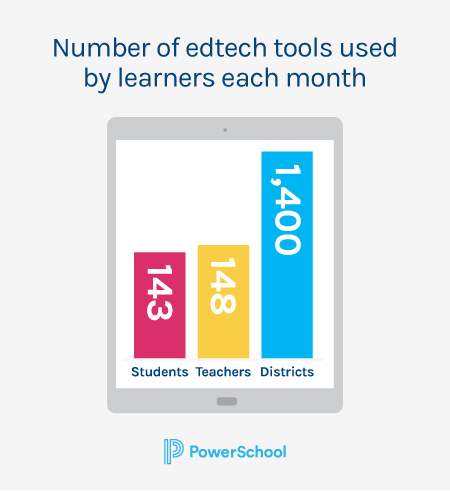Interoperability–when software systems communicate with each other–remains a core focus of K-12 tech departments, and for good reason. Interoperable K-12 technology solutions can go a long way toward helping districts operate more efficiently and effectively. They reduce the strain on IT staff. Interoperable solutions free teachers from the burden of juggling multiple accounts and transferring data from one program to another. They also empower educators with better and more complete insight into student performance through the seamless integration of data.
While different solutions may have different features, strengths, and weaknesses, interoperable technology generally checks three key boxes:
- Single sign-on (SSO)
- Common user experience
- Common data model
With these pillars in place, such as classroom products from PowerSchool, you can construct an interoperable classroom technology system that unifies administrative tasks, content delivery, and assessment of student learning in a highly efficient way. Taken further, PowerSchool’s full suite of interoperable solutions, including PowerSchool SIS, PowerSchool talent products, and PowerSchool payroll/finance system products, bring all of a district’s core operations into a secure and efficient integrated ecosystem.
Benefits of Single Sign-On for K-12 Education Technology

Single sign-on eliminates those issues with a single account for all connected programs. SSO also saves your IT department from spending time troubleshooting login issues. For instance, a K-12 district administrator would need one login and password to access all their important edtech systems, including the LMS, SIS, curriculum mapping and lesson planning tool, behavior support tool, special education tool, registration program, and assessment system. Additionally, students would need just one login and password to access their most frequently-used edtech tools.
Perhaps most importantly, SSO improves overall data security. Maintaining multiple applications with separate sign-in processes creates an environment ripe for unauthorized access and data breach. Partnering with providers that support SSO—among other best-in-class security measures—makes managing user access and permissions for the entire tech stack easier.
PowerSchool classroom products —including PowerSchool Schoology Learning, PowerSchool Performance Matters, PowerSchool Curriculum and Instruction, and PowerSchool Behavior Support—all have SSO capabilities, making it easy for educators and staff to manage all facets of the K-12 educational experience. For example, an educator teaching from Schoology Learning can simply toggle over to Behavior Support and enter a behavior observation for a student who arrived on time. There’s no need to log in again, which saves teachers time and allows them to focus on what matters most.
TX

When we’re looking at interoperability with Schoology and eSchoolPlus, we know already that there’s this secure data exchange, and it’s seamless.
Julie Pedraza Supervisor, Management Information Systems
Brownsville ISD
Interoperable Edtech Provides a Common User Experience
Single sign-on isn’t the only element of interoperable technology that saves users time and adds convenience. A common user interface simplifies navigation within and between applications. It reduces training needs and the general IT burden because staff members (and students) don’t have to learn a new process for each new addition to the district’s edtech system. Nor do they feel like they have to re-learn an interface every time they log in to an existing one–a common frustration.
K-12 education has the added benefit of making life easier for parents and families by giving them a simpler way to find student and school information. By extension, this simplifies work for school administrators, who no longer have to field as many phone calls from frustrated parents.
Let’s return to the “stack” concept for just a moment. Imagine your edtech systems “stacked” one on top of the other. The foundation is the SIS–where you look up student schedules, run transcripts, locate contact information, and more. One level up is your LMS, where teaching, learning, and assessment live. The top level is a repository of skills and content.2 Now, imagine if each of these levels contains a common user experience. When moving between the levels, students, teachers, and parents experience the same interface and don’t have to learn new skills to navigate each level. That’s the power and promise of true interoperability.
A Common Data Model Makes the Most of Your Student and District Data
Interoperable applications can share data, eliminating the need for time-consuming import/export tasks and correcting errors from duplicative manual data entries. This is particularly useful in K-12 education, where attendance, grading, and assessment data help educators and families support students. When information moves seamlessly from assessment and learning management software to the SIS, it’s much easier for teachers and parents to get the big picture.
Before instituting an interoperable system, you might have to export unit assessment data from your LMS to your gradebook and then explain everything to students and their parents multiple times. After instituting an interoperable system, such as classroom products from PowerSchool, that process is seamless and coherent for all stakeholders. Teachers don’t want to manually input data into multiple applications. Students and parents just want all information related to academic achievement and growth on one dashboard, not scattered all over the place (EdSurge, 2021).
Imagine the possibilities. Let’s say you’re in a team-teaching setup. You give a short-cycle formative assessment, like a quick comprehension quiz. The data is automatically gathered and synced via the LMS. Analyze results in real time, and you and your co-teacher can immediately address any gaps or misunderstandings by providing additional clarification, re-teaching concepts, and more. Another comprehension quiz demonstrates that all students have improved their understanding of the topic(s) due to this immediate intervention. Results automatically feed into the SIS and are available for viewing by students and parents. This is a world away from what is happening in classrooms that have yet to discover the value of interoperable technology.
Bringing it All Together
Clearly, getting your software connected has a wide range of benefits. Interoperable technology can significantly impact district success by providing better insight into student performance and reducing stress for teachers and support staff.
Want to take a deeper dive into how your district can build a more effective technology ecosystem with interoperable solutions? Get more information on everything interoperability, including benefits and implementation strategies, in this guide from the Center for Digital Education. Then, check out how the classroom products from PowerSchool can bring it all together for you, from your LMS and SIS to tracking, reporting, and acting on meaningful data. You’ll be on the path to true interoperability–and happier and more productive students and families–in no time.
K-12 Classroom Management Platform Buying Guide
Learn how to find the right classroom management platform for your school or district.
Get Your CopyResources
- Molnar, M. (2020, July 8). Number of ed-tech tools in use has jumped 90 percent since school closures. EdWeek Market Brief. https://marketbrief.edweek.org/marketplace-k-12/access-ed-tech-tools-jumped-90-percent-since-school-closures/
- Ibid



